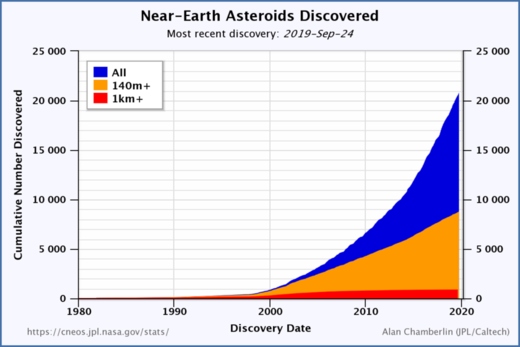Asteroid swarm: Nasa detects 16 space rocks hurtling towards Earth this week
The largest asteroid from the group is bigger than the Great Pyramid of Giza in Egypt. According to the agency’s Centre for Near-Earth Object Studies (CNEOS), Earth will see a total of seven asteroids fly past on October 8. As noted by CNEOS, these asteroids are 2019 TU, 2019 TW1, 2019 RK, 2019 TC1, 2019 SB6, 2019 TM and 2019 TS.
These asteroids will arrive starting early on Tuesday.
Although most of these asteroids will approach Earth from very safe distances, one of them is expected to fly close to the planet.
According to CNEOS, 2019 T1 will zip past the planet from 0.00378 astronomical units or roughly 351,000 miles away, which is just slightly greater than the distance between the Earth and the Moon.
The next group of asteroids will enter Earth’s locality on October 9.
These asteroids, namely 2019 TV1, 2019 TZ and 2019 SL7 will be heading past Earth early in the morning UK time on this date.
With diameters ranging from 29 to 38 meters, the approaching asteroids are relatively small but would deadly if they made impact.
Asteroid, 2019 TV1 and 2019 TZ will fly past Earth from millions of miles away while 2019 SL7 will approach Earth from a distance of only 0.00363 astronomical units or about 337,000 miles away.
Only one asteroid will zip past Earth on October 10.
It is known as 2019 SX5, this asteroid is the largest one from the group with an estimated diameter of 140 meters.
This Great Pyramid sized asteroid will approach the Earth on October 10.
It should stay at a distance of 0.04533 astronomical units or about 4.2 million miles away.
On Saturday, October 12, Earth will be visited by four more asteroids.
Compared to 2019 SX5, the asteroids 2019 TN1, 2019 SK8, 2019 SV9 and 2019 SE2 are significantly smaller with diameters averaging from 25 to 90 meters.
These four asteroids are expected to visit Earth’s vicinity early on Saturday UK time.
The last asteroid that will fly by Earth this week is called 2019 TT1.
This 38-meter-wide asteroid will approach Earth on October 13 at a distance of 0.00744 astronomical units or about 692,000 miles away.
Nasa has said SL7 will fly around 1.4 lunar distances from the moon - around 538,162 kolmoetres away, meaning the rock will be classed as a near-Earth object (NEO).
The distance will mean Nasa study the asteroid as it passes.
Nasa describes NEOs as comets and asteroids which have been "nudged by gravitational attraction of nearby planets into orbets that allow them to enter the Earth's neighbourhood".
The space agency added: "If we wish to know the composition of the primordial mixture from which the planets formed, we must determine the chemical constituents of the leftover debris from the formation process - the coments and asteroids".
It was recently revealed that NASA is stepping up its preparations to deal with the “God of Chaos” rock Apophis which could arrive in the next 10 years.
Even SpaceX founder Elon Musk has responded by issuing a chilling assessment over our planet’s defence capabilities against artificial intelligence going wrong and an asteroid impact.
Mr Musk said we “currently have no defence” against these huge space rocks.
An asteroid the size of Apophis has the potential to create devastation on a planetary scale.
The last time we saw that was 66 million years ago, when the dinosaurs were wiped out.
Q: (L) Well, thanks a lot! (Ailen) That's a nice way of saying, "No dice!" (L) Okay, as you know, we had a wonderful little exploding comet fragment out there in Russia that did some serious damage and injured lots of people. I'm not glad that it injured lots of people, but I just think it was pretty interesting that this happened like within three days of our new book "Comets and The Horns of Moses" being released in hardcopy. So, I guess the first question is: Anything to tell us about the exploding comet fragment, or whatever they wanna call it? It could have an asteroid, or it could have a comet fragment, or whatever?
A: Denatured comet but who's counting?
Q: (L) Okay. Is that all you're gonna say?
A: Just wait for the next one! That one will be a doozie! And it has "friends!"








